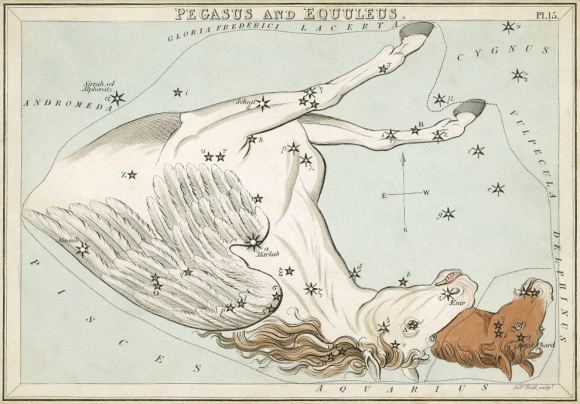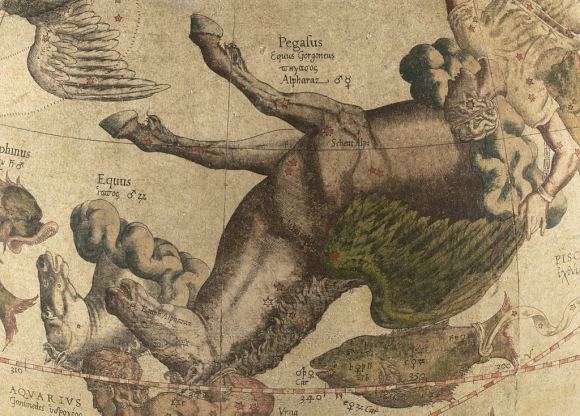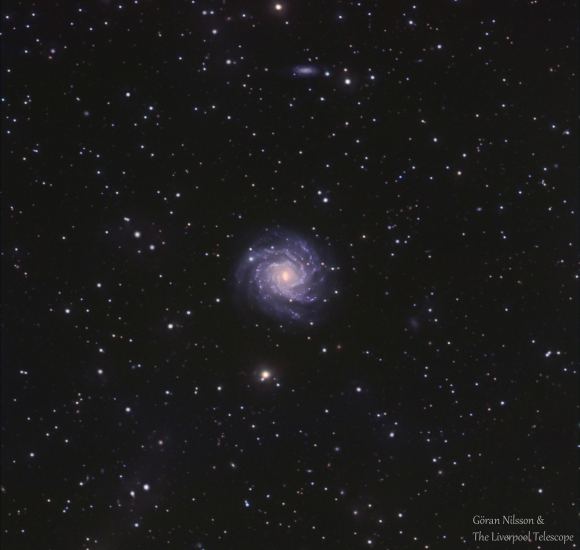Welcome to another edition of Constellation Friday! Today, in honor of the late and great Tammy Plotner, we take a look at the “little horse” – the Equuleus constellation. Enjoy!
In the 2nd century CE, Greek-Egyptian astronomer Claudius Ptolemaeus (aka. Ptolemy) compiled a list of the then-known 48 constellations. This treatise, known as the Almagest, would be used by medieval European and Islamic scholars for over a thousand years to come, effectively becoming astrological and astronomical canon until the early Modern Age.
One of these constellation is Equuleus (aka. “little Horse”), a constellation that lies in the northern sky. This small, faint constellation is the second smallest in the night sky, after Crux (the Southern Cross). Today, it is one of the 88 modern constellations recognized by the International Astronomical Union (IAU) and is bordered by the constellations of Aquarius, Delphinus and Pegasus.
Name and Meaning:
Equuleus literally means “Little Horse” (of foal) in Latin. In Greek mythology, the constellation was mainly associated with the foal Celeris, whose name means “swiftness” or “speed” in Latin. Celeris, the offspring of the mighty winged horse Pegasus, was a gift given to Castor by the messenger god, Mercury.

As the legend goes, Equuleus is the horse struck from Neptune’s trident during the contest between him and Athena, which was to determine which of them would be the superior. Because this section of stars rises before Pegasus, it is often called Equus Primus, or the First Horse. Equuleus is also linked to the story of Philyra and Saturn, the parents of Chiron who may represent the constellation of Centaurus.
Equuleus is also associated with Hippe, the daughter of the Chiron in Greek mythology who was seduced by Aeolus and became pregnant with his child. Ashamed, Hippe hid the pregnancy from Chiron and escaped to the mountains where she stayed until she gave birth to the child – named Melanippe.
When Chiron came looking for Hippe, she prayed to the gods that he would not find her. In response, they turned her into a mare and Artemis placed her among the constellations. In accordance with this myth, Hippe still appears to be hiding from Chiron (represented by Centaurus) in the night sky, with only her head showing behind Pegasus.
History of Observation:
Equuleus, despite having no bright stars, was one of the constellations recognized by Greek astronomer and mathematician Hipparchus, and went on to be one of the 48 constellations included by Ptolemy is his 2nd century CE tract, the Almagest. Today, it is recognized by the IAU as one of the 88 modern constellations.

Notable Features:
Equuleus has no stars brighter than the fourth magnitude, but still retains several prominent ones. Its brightest star, Alpha Equulei (aka. Kitalpha), is a spectroscopic binary star located approximately 186 light years away. The star’s name is derived from the Arabic phrase qit‘a(t) al-faras which means “a piece (or section) of the horse.”
It second brightest star is Delta Equulei, another binary star system located approximately 60.3 light years from Earth. Next up is Gamma Equulei (5 Equulei), a double star located 118 light years away. This star undergoes occasional variations in brightness due to its peculiar chemical nature and is classified as a rapidly oscillating Ap (roAp) star.
There’s also Beta Equulei, a main sequence blue-white dwarf star that is about 360 light years distant from Earth. Also significant is HD 200964, a subgiant that is some 223 light years away and has two confirmed exoplanets in orbit. The closer planet is almost double the mass of Jupiter while the more distant planet is slightly less massive than Jupiter. The planets orbits the star with a period of 614 and 825 days, giving them an orbital resonance of 4:3.
Equuleus has only a few Deep Sky Objects associated with it. These include NGC 7015, a galaxy that is about 212 million light years distant; NGC 7040, a spiral galaxy located 260 million light years away; and NGC 7046, a barred spiral galaxy located 180 million light years away.

Finding Equuleus:
Covering only 72 square degrees and possessing 3 main stars, Equuleus harbors on 10 stars with Bayer/Flamsteed designations. It is bordered by the constellations of Aquarius, Delphinus and Pegasus. Equuleus is visible to all observers at latitudes between +90° and -80° and is best seen at culmination during the month of September.
Now, let’s roam around the skies of Equuleus with binoculars, starting with Alpha, the “a” shape on our map. Alpha Equulei proper name is Kitalpha, which means “part of the horse”. What it is… is a unique spectroscopic binary star. At a distance of about 186 light years from Earth, Kitalpha shines away merrily about 75 times brighter than our Sun.
But the class G primary giant star is dying – its helium core contract. Nearby is its white dwarf companion. Very nearby. These two stars are so close together that the stellar spectral class is mixed, G + A, with two spectra present at the same time. What’s happening? The dwarf companion star is unevolved hydrogen-fuser. One day the mass transfer between the two should lead to some very interesting conclusions!
Point your binoculars towards Delta – the figure “8” shape on our map. Delta Equulei goes by the name Pherasauval, which loosely means “the first horse”. Pherasauval is a binary star system with a class G0 star and a class F5 one. What makes it a real curiosity is because its mass can’t quite be determine – and because we’re looking at a pair of stars that are pretty much the same as our own Sun at a distance of 60 light years from our solar system. Take a look through a telescope to split this pair apart and dream of what it would be like to be a planet where two suns were always in the sky!

Now take a look a Gamma Equulei – the “Y” shape on our map. This is an easy double star to split with binoculars (A and D), but use a telescope because this is a multiple star system! The primary star (A) is magnitude 4.7 and the B star (secondary) is a disparate magnitude 11. A bit further away, look for an optical 12th magnitude companion and a 6th magnitude D star as well!
While there are almost no deep sky objects bright enough to be hunted down with most amateur telescopes, larger aperture telescopes might be interested in trying their luck with 13th magnitude NGC 7015 (RA 21:05.7 Dec +11:25). Also known as Stephan IX, this faint lenticular galaxy was was catalogued for the first time in 1888 in the New General Catalogs by the Danish astronomer John Dreyer.
If you’re really challenged, try your hand at a small group of galaxies head by UGC 11697 (RA 21h 12m 06.0s Dec +11 38′ 00″). At magnitude 15 and about 1 arc minute in size, you’re going to have fun spotting it!
We have written many interesting articles about the constellation here at Universe Today. Here is What Are The Constellations?, What Is The Zodiac?, and Zodiac Signs And Their Dates.
Be sure to check out The Messier Catalog while you’re at it!
For more information, check out the IAUs list of Constellations, and the Students for the Exploration and Development of Space page on Canes Venatici and Constellation Families.
Sources:

